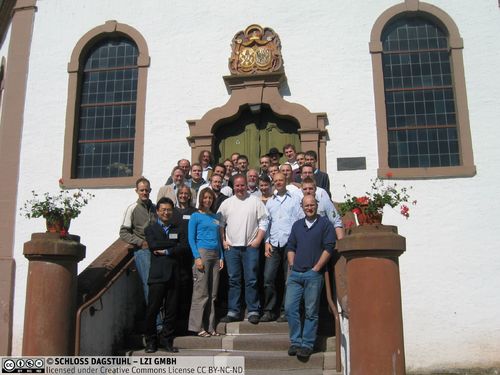Dagstuhl Seminar 07181
Parallel Universes and Local Patterns
( May 01 – May 04, 2007 )
Permalink
Organizers
- Michael R. Berthold (Universität Konstanz, DE)
- Katharina Morik (TU Dortmund, DE)
- Arno Siebes (Utrecht University, NL)
Contact
Learning in parallel universes and the mining for local patterns are both relatively new fields of research. Local pattern detection addresses the problem of identifying (small) deviations from an overall distribution of some underlying data in some feature space. Learning in parallel universes on the other hand, deals with the analysis of objects, which are given in different feature spaces, i.e. parallel universes; and the aim is on finding groups of objects, which show ``interesting'' behavior in some of these universes. So, while local patterns describe interesting properties of a subset of the overall space or set of objects, learning in parallel universes also aims at finding interesting patterns across different feature spaces or object descriptions. Dagstuhl Seminar~07181 on Parallel Universes and Local Patterns held in May 2007 brought together researchers with different backgrounds to discuss latest advances in both fields and to draw connections between the two.
The goal of the proposed workshop was threefold. Firstly, we wanted to bring together researchers from the different disciplines to agree on a unifying framework for local pattern mining in parallel universes. So far, only algorithms that find clusters as local patterns have been proposed, for example for the grouping of active molecular compounds or the modeling of user preference clusters in different musical genres. It is not straight forward to extend this scenario to other types of pattern mining algorithms, which requires a careful study of the state of the art and a combination of existing approaches. Secondly, the interaction between different local patterns is an aspect that hinders existing algorithms. If a pattern belongs to two or more local patterns or, inversely, if two local patterns in different universes describe overlapping subsets of the data it becomes more complicated to algorithmically derive the entire set of local patterns that may exist in the data. Thirdly, the workshop aimed to produce a series of white papers describing the state of the art in local pattern mining in application areas where related problems have appeared in the past. In order to achieve this, we invited researchers from different communities: local pattern mining, statistical data analysis, machine learning, and data mining. In addition we also invited participants from the Visual Data Mining community, since local pattern detection -especially in several descriptor spaces in parallel- is a method that inherently requires user feedback to be successful (Rudolf Kruse, Matthias Steinbrecher). For this, it is crucial to be able to present the user with a variety of -preferably interactive- views on the data (Arno Knobbe), each showing summaries of the discovered patterns in each universe together.
- Niall Adams (Imperial College London, GB) [dblp]
- Ira Assent (RWTH Aachen, DE) [dblp]
- Michael R. Berthold (Universität Konstanz, DE) [dblp]
- Francesco Bonchi (CNR - Pisa, IT) [dblp]
- Jean-François Boulicaut (INSA - Lyon, FR) [dblp]
- Bruno Crémilleux (Caen University, FR) [dblp]
- Ad J. Feelders (Utrecht University, NL)
- Elisa Fromont (KU Leuven, BE) [dblp]
- Johannes Fürnkranz (TU Darmstadt, DE) [dblp]
- Bart Goethals (University of Antwerp, BE) [dblp]
- Frank Höppner (FH Wolfenbüttel, DE)
- Frank Klawonn (Ostfalia Hochschule - Wolfenbüttel, DE)
- Arno J. Knobbe (Utrecht University, NL) [dblp]
- Rudolf Kruse (Universität Magdeburg, DE)
- Taneli Mielikäinen (NRC - Palo Alto, US)
- Ingo Mierswa (TU Dortmund, DE)
- Katharina Morik (TU Dortmund, DE) [dblp]
- Céline Rouveirol (University of Paris North, FR)
- Stefan Rüping (Fraunhofer IAIS - St. Augustin, DE)
- Tobias Scheffer (MPI für Informatik - Saarbrücken, DE) [dblp]
- Martin Scholz (TU Dortmund, DE)
- Jouni K. Seppänen (Helsinki University of Technology, FI)
- Arno Siebes (Utrecht University, NL) [dblp]
- Matthias Steinbrecher (Universität Magdeburg, DE)
- Einoshin Suzuki (Kyushu University, JP)
- Edward A. Tricker (Imperial College London, GB)
- Claus Weihs (TU Dortmund, DE)
- Bernd Wiswedel (Universität Konstanz, DE)
Related Seminars
- Dagstuhl Seminar 04161: Detecting Local Patterns (2004-04-12 - 2004-04-16) (Details)
Classification
- data bases / information retrieval
- soft computing
- interdisciplinary
Keywords
- Data mining
- local patterns
- anomaly detection
- parallel universes


